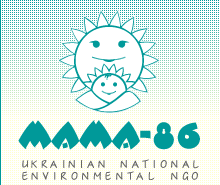Analysis of the Opinion Poll
With the purpose to study public opinion, activist of MAMA-86 developed a questionnaire to examine patients', spatially parents', opinion on:
- state of the environment;
- quality of the environment and human health;
- rational use of natural resources;
- protection of the environment in general;
- diagnostic's expediency for children and their parents.
During nine months (August 2002—April 2003) patients diagnosed by the Foll method filled in 181 questionnaires. Mostly residents of the Kyiv city and region (Boyarka, Bucha, Nizhyn, Rokytne, Tarasivka) were questioned. Most of questionnaires (90%) were filled by women 30-40 years old. Half of respondents have higher education, 29% — specialized secondary education, 15% — secondary education and other — incomplete education.
Processed data of opinion poll allow estimating doctors' assistance (O. Kravchuk, G. Protsenko) in providing diagnostic. All respondents answered that were satisfied in response to the question “What is your impression of the diagnostics?”
Analysis of questions on the main negative factors influencing health revealed that adverse environment, insufficient rest, and everyday troubles are among factors that have a negative impact on human health.
With regards to dependence of quality of the environment and human health, respondents pointed in the first place poor quality of tap water.
Other environmental concerns of respondents were placed by the regional priorities. Thus, the residents of the Kyiv city are disturbed by air pollution; the residents of the Kyiv region (Boyarka, Bucha, Nizhyn, Rokytne, Tarasivka) are worried by radiation state.
Poor public awareness of environmental state of the district of residence arouses concerns. Majority of the respondents (87%) are virtually not familiarized with environmental issues. Only 13 % of people are aware of such topic and consider themselves to be informed.
More than 90% of respondents mentioned mass media (TV, newspapers, magazines and radio) as a main source of information. Only 3% of respondents get environmental information from contacts with representatives NGOs. This fact causes the concerns and ensures the necessity to conduct the awareness raising campaign in future.
70% respondents in response to the question on the sources of environmental information and education for the children noted the leading role of school and kindergarten teachers in environmental education. We are concerned with the fact that 30% respondents mentioned the absence of environmental information for the youth at all.
Respondents' answers on sources of water consumption varied:
35% —use water from tap;
25% — use artesian water;
25% —purify additionally tap water;
15% — use the bottled water.
More than half of questioned respondents (52%) prefer plastic packaging.
As a result of analysis, one should note that using water, gas or heat meters in households is not popular enough at present:
26% — installed cold water meters;
15% — installed hot water meters;
6% — installed heat meters; and
4% — installed gas meters.
Average amount of water consumption per day:
5% — consume 500 litres;
24% — consume 300 litres;
71% — consume 100 litres.
Most of the respondents have a general idea about separation of domestic wastes. Almost half of the respondents admitted lack of information on this issue. Only 13 % of the respondents declared to be informed in detail.
More than half of the respondents (80%) gave a positive answer concerning their readiness and willingness to separate domestic wastes, while only 20% are not ready to do it.
Only 28 % of the respondents permanently use the energy saving electric light bulbs. Majority of questioned (72%), whose don't use energy saving electric light bulbs, even haven't heard about it.
Almost nobody (69%) is informed about local environmental and health action programs or plans.
Population of the Kyiv city and region is virtually not acquainted with a sustainable development concept. Only one third of the respondents have got an idea on the matter of sustainable development.
With regard to holding the Fifth Ministerial Conference “Environment for Europe”, only 3% of the respondents are aware on this matter, the rest of respondents have no idea about it.
Conclusion
Regarding obtained results, we consider further conducting of the questioning to be expedient.
Opinion poll results demonstrated low level of general public awareness on the environmental issues.
Obtained results provide clear illustration of the necessity to carry out the following activities in the future:
- providing and disseminating environmental information through the “Eco-Telephone” hot-line, mass media and environmental actions;
- raising environmental awareness among pupils, youth and general public;
- involving and stimulating the public for resolving environmental problems on the local and the national level.
Results of the questioning can be used under the operating projects of MAMA-86 and as statistical data for the new project proposals preparation and development of new questionnaires.
